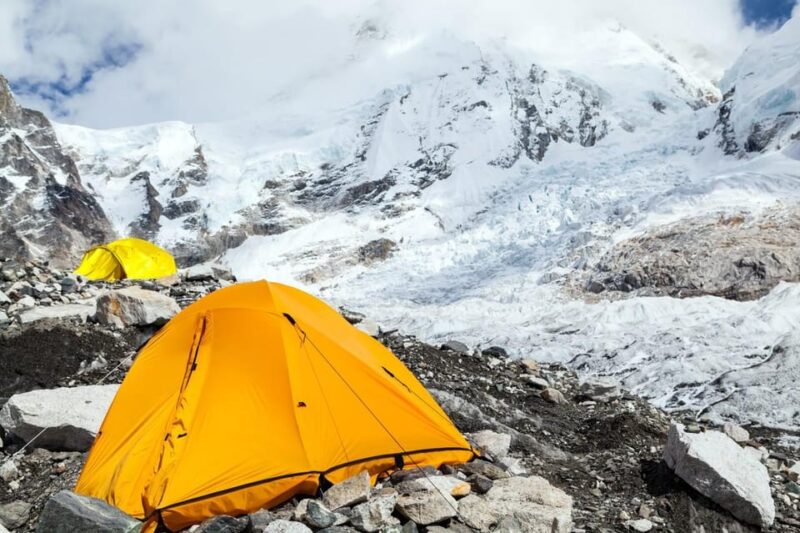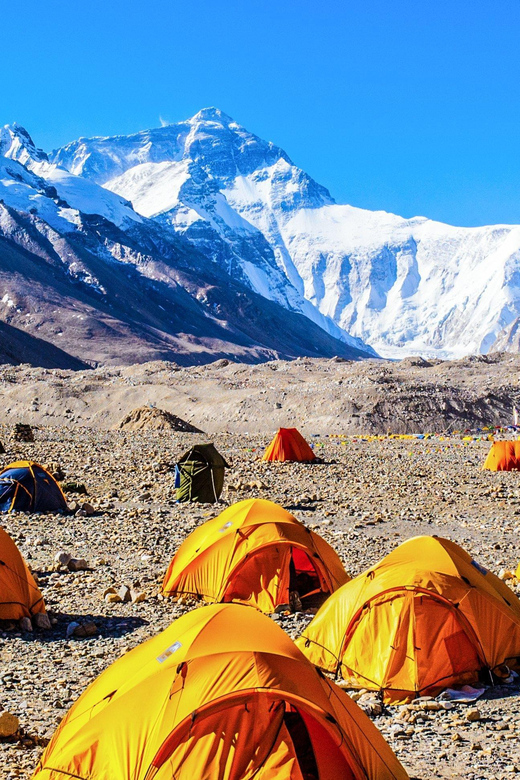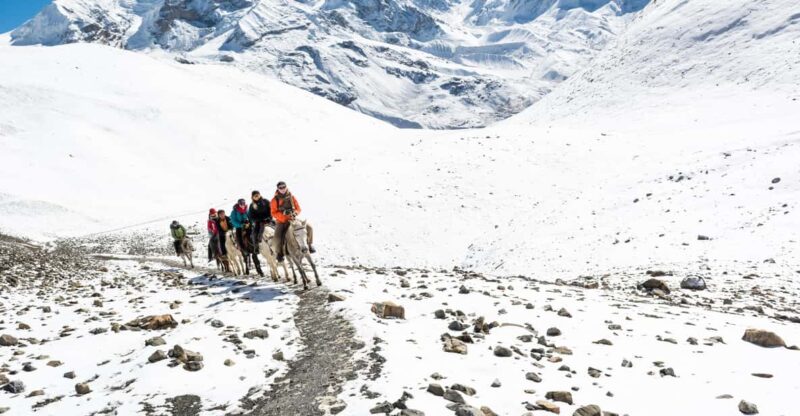When considering a ride on horseback to Everest Base Camp, one quickly realizes it’s not just about the destination but the journey itself. Riders traverse stunning landscapes, encounter vibrant Sherpa culture, and gradually acclimatize to the altitude, thanks to experienced guides. This 15-day trek offers a unique blend of adventure and breathtaking scenery, culminating at the impressive Kala Patthar viewpoint. However, planning such an expedition involves more than just booking a spot. There are essential tips and insights that every potential rider should know before setting off on this remarkable adventure.
Key Points
- The trek to Everest Base Camp includes horse riding options, enhancing the experience of traversing through scenic Sherpa villages and landscapes.
- Starting from Kathmandu, the journey features acclimatization days to ensure comfort and safety during horse riding.
- Experienced guides accompany riders, providing support and cultural insights into the Sherpa way of life throughout the trek.
- Essential preparations include wearing comfortable shoes, layering clothing, and carrying a durable backpack for organization during the ride.
- Hydration and pacing are crucial; take breaks and drink plenty of water to maintain energy levels while riding.
Overview of the Trek

The horse riding trek to Everest Base Camp offers adventurers an unforgettable journey through the breathtaking Himalayas, all for a starting price of $2,609.01 per person.
Spanning 15 days, this trek includes acclimatization days to help travelers adjust to the altitude. Starting in Kathmandu, riders will traverse stunning landscapes, experiencing the majesty of Mount Everest and other peaks up close.
Along the way, they’ll ride alongside the Dudh Koshi River and explore charming Sherpa villages, seeing local culture.
It’s essential to pack wisely, bringing comfortable shoes, warm clothing, and a good camera.
With experienced guides and porters included, travelers can focus on enjoying the scenery and the adventure of a lifetime.
You can also read our reviews of more tours and experiences in Namche Bazar.
Itinerary Highlights

Riders can look forward to an exciting 15-day itinerary that takes them from the vibrant streets of Kathmandu to the majestic heights of Everest Base Camp. Each day offers unique experiences, from cultural sightseeing to breathtaking mountain vistas.
Here’s a quick overview of the itinerary highlights:
| Day | Activity | Elevation (m) |
|---|---|---|
| Day 1 | Arrival in Kathmandu | 1,338 |
| Day 3 | Fly to Lukla, ride to Phakding | 2,610 |
| Day 5 | Acclimatization at Namche, ride to Hotel Everest View | 3,880 |
Each leg of the journey reveals stunning landscapes, local Sherpa culture, and unforgettable moments, ensuring riders have a thrilling adventure.
Trekking Experience

Embarking on this horse riding trek offers adventurers a unique way to explore the stunning landscapes and rich culture of the Khumbu region.
Riders follow the Dudh Koshi River, meandering through picturesque Sherpa villages and breathtaking mountain scenery. Along the way, they’ll encounter iconic sites like the Kala Patthar viewpoint and the serene Tengboche Monastery.
This experience isn’t just about the views; it’s a chance to learn about the Sherpa lifestyle, traditions, and their deep connection to these majestic mountains.
To make the most of the trek, adventurers should wear comfortable shoes, dress in layers for changing weather, and bring a camera to capture unforgettable moments.
Embrace the journey and learn about this extraordinary adventure!
Inclusions and Exclusions
Understanding what’s included and excluded in the trek package is key for planning a hassle-free adventure to Everest Base Camp.
The package generally covers private vehicle transfers, three nights in a comfortable Kathmandu hotel, meals during the trek, and experienced guides and porters. Round-trip flights from Kathmandu to Lukla, national park permits, and a first aid kit are also included.
On the flip side, travelers should note that meals in Kathmandu (lunch and dinner), travel insurance, and international airfare aren’t part of the package.
Personal expenses like drinks and laundry, tips for guides and porters, and any emergency evacuation costs are also excluded.
Being aware of these details helps ensure a smooth trekking experience.
More Great Tours NearbyImportant Information
Planning ahead is crucial for a successful trek to Everest Base Camp, so being aware of essential information can make all the difference. Here’s a quick overview of what trekkers should keep in mind:
| Key Information | Details |
|---|---|
| Cancellation Policy | Free cancellation up to 24 hours |
| Payment Options | Reserve now & pay later |
| What to Bring | Comfortable shoes, warm clothing, camera, sunscreen, water |
| Validity | 15 days from first activation |
Packing Essentials
When gearing up for the horse riding trek to Everest Base Camp, having the right packing essentials can make the adventure not only enjoyable but also comfortable.
Here’s a quick list of must-haves:
-
Clothing Layers: Breathable base layers, insulating mid-layers, and waterproof outer layers are crucial to tackle varying temperatures.
-
Footwear: Comfortable, sturdy boots are a must for riding and walking. Don’t forget a pair of warm socks!
-
Gear and Accessories: A good quality helmet, riding gloves, and a durable backpack will keep you safe and organized throughout the trek.
Tips for a Successful Ride
Packing the right gear is just the beginning; knowing a few tips for a successful ride can greatly enhance the experience on the trek to Everest Base Camp.
First, riders should prioritize comfort and safety by getting accustomed to their horses before the trek. Establish a good rapport with the animal to build trust.
Plus, maintain steady communication with guides about any concerns—keeping them informed can prevent potential issues.
Staying hydrated is crucial, so drink plenty of water throughout the ride.
Riders should also pace themselves, taking breaks when needed to avoid fatigue.
Lastly, be open to flexibility in the itinerary; unexpected changes can lead to memorable experiences.
Following these simple tips can make the journey more enjoyable and safe.
Cultural Insights

Understanding the rich culture of the Sherpa people enhances the trekking experience to Everest Base Camp, offering insights into their traditions, lifestyle, and deep connection to the mountains.
Here are three cultural highlights to appreciate during the ride:
-
Hospitality: Sherpas are known for their warm hospitality. Visitors often find themselves welcomed with tea and local delicacies in villages along the route.
-
Spirituality: The Sherpa’s deep spiritual connection to the Himalayas influences their way of life, with monasteries and prayer flags dotting the landscape.
-
Traditional Practices: Observing traditional farming methods and local craftsmanship provides a glimpse into the Sherpa’s sustainable lifestyle.
Engaging with the Sherpa culture enriches the journey, making each day on the trail even more meaningful.
Frequently Asked Questions
What Is the Best Time of Year for This Trek?
The best time for this trek is during spring (March to May) and autumn (September to November). During these months, temperatures are milder, and the weather’s generally clearer, making for stunning views and enjoyable riding.
Are Horses Provided or Should I Bring My Own?
For this trek, horses are provided, so there’s no need to bring your own. Participants can focus on enjoying the ride and stunning scenery without worrying about equipping their own mounts.
What Level of Riding Experience Is Required?
For this trek, riders need basic experience. They should be comfortable on a horse and capable of handling diverse terrain. If unsure, it’s best to discuss their skills with the tour organizers beforehand.
How Do I Prepare My Horse for High Altitudes?
To prepare a horse for high altitudes, it’s crucial to gradually acclimatize them. Start with shorter rides, increase intensity slowly, and ensure they stay hydrated. Regular check-ups can also help monitor their health and adjust accordingly.
Can I Join the Trek Solo or Only in Groups?
She can join the trek solo or in groups, depending on her preference. Many travelers enjoy the camaraderie of group trekking, but solo options are available for those seeking a more personal experience.
Recap
Riding a horse to Everest Base Camp is an unforgettable adventure that combines stunning landscapes and rich cultural experiences.
With the right preparation and a spirit of adventure, anyone can enjoy this unique journey.
Whether you’re soaking in the views from Kala Patthar or connecting with the local Sherpa communities, each moment is sure to leave a lasting impression.
So gear up, pack wisely, and get ready for the ride of a lifetime in the heart of the Himalayas!
You can check availability for your dates here:More Horses in Namche Bazar
More Tour Reviews in Namche Bazar
Not for you? Here's more nearby things to do in Namche Bazar we have reviewed
- Everest Base Camp Trek – 12 Days Guided Trek
- Lobuche Peak Climbing 2025/2026
- Everest Panorama Trek-10 Days
- Lobuche Peak Climbing with EBC TREK-18 Days
- Everest Base Camp, Cho-La Pass, and Gokyo Trek
- Guided: Everest Base Camp Trek
- Pokhara: 11-Day Everest Base Camp Trek
- Everest Base Camp Trek
- Everest: 6-Day Panorama Trek
- 12 days Everest Base Camp Trek
- 5-Day Everest Tour with Breakfast at Everest View Hotel
- 8 DAYS EVEREST PANORAMA VIEW TREK FROM KATHMANDU
